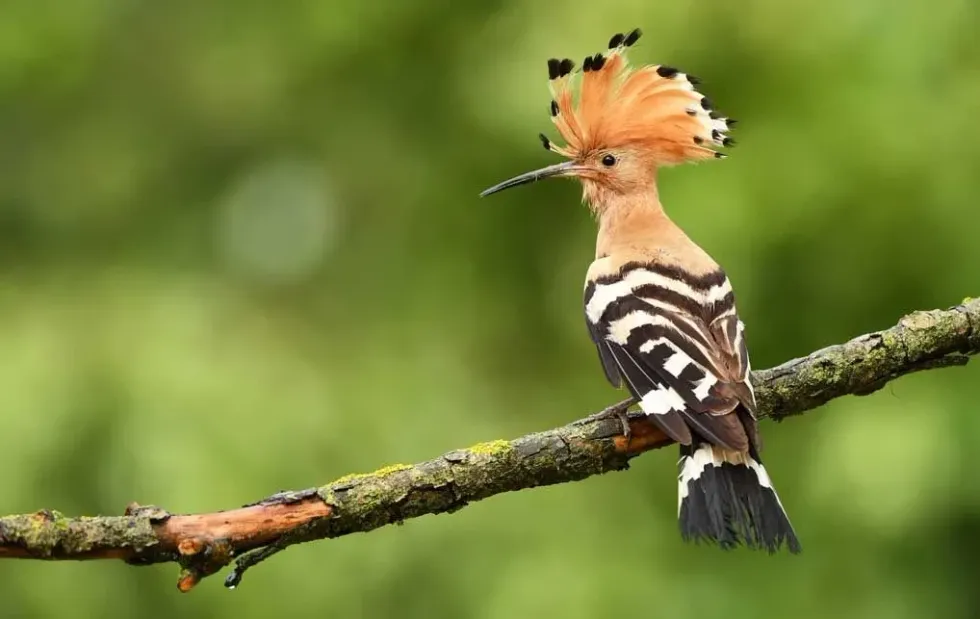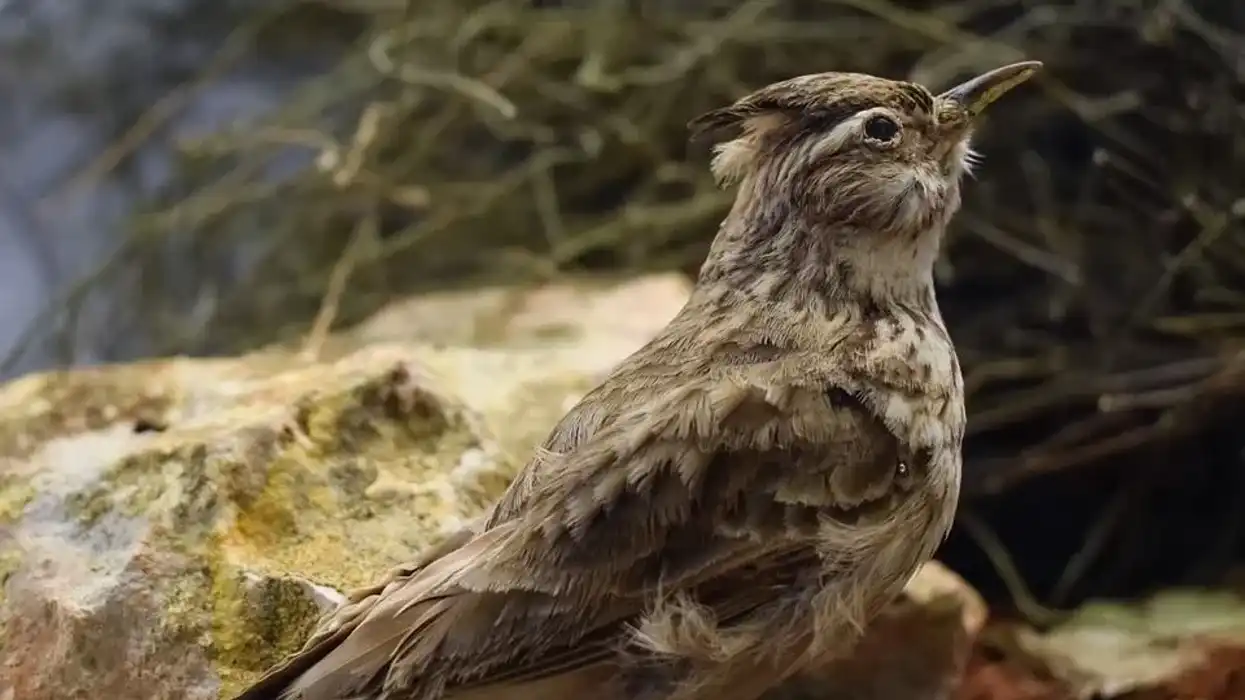The Eurasian hoopoe is a medium-sized bird in the hoopoe family. The species is easily identifiable by its long, slender tapering bill and black and fawn bottom.
Because of the increased muscle in its skull, the bill can be opened when digging in the ground. The hoopoe is a fast-flying bird with broad, rounded wings. These birds are also found all across the world.
They can be seen in locations such as Asia, Europe, and even the farthest locations of Africa! This well-traveled bird has a significant wingspan - which allows it to fly long distances without tiring out.
There is so much to know and learn about the Eurasian hoopoe, and you can read it all by scrolling right ahead! If you want to know more about the various birds in our world, then you should definitely check out forest falcon facts and saker falcon facts!
Eurasian Hoopoe Interesting Facts
What type of animal is a Eurasian hoopoe?
The Eurasian hoopoe is a type of bird.
What class of animal does a Eurasian hoopoe belong to?
They belong to the class Aves.
How many Eurasian hoopoes are there in the world?
The Eurasian hoopoe (Upupa epops) is the most widely distributed species in the genus Upupa, occurring throughout Asia, Europe, including northern Africa. It is classified into seven separate subspecies based on geographical locations. About five to ten million hoopoes are living globally.
Where does a Eurasian hoopoe live?
The hoopoe bird lives in the Savanna. Hoopoes' seasonal movements vary considerably depending on their region.
For example, the Eurasian hoopoe range in temperate zones of Asia and much of Europe commonly migrates towards southern Asia or Africa in the winter months. On the other hand, African hoopoes (Upupa africana) spend most of their time in the same area throughout the year.
What is a Eurasian hoopoe's habitat?
The Eurasian hoopoe's habitat is in tropical and temperate areas, where they can find woods, grasslands, and savannas. They require a large amount of open space with scarce vegetation and trees, as well as rocks or walls to live in. Unlike most bird species, which build intricate nests in trees, the hoopoe makes do with tiny cracks.
Who do Eurasian hoopoes live with?
Hoopoes are primarily solitary species who hunt and feed on their own, except for breeding and child-rearing. The Eurasian hoopoe is an Old World species that may be found across much of Europe, South Asia, and regions of Africa. However, they are incredibly rare vagrants in North America.
How long does a Eurasian hoopoe live?
In the wild, a Eurasian hoopoe life is about 10 years. However, the lifespan of the little bee-eater, which belongs to the same class as the hoopoe, is between 12-18 years.
How do they reproduce?
Hoopoes hunt for holes in trees, cliffs, trunks, and walls (on vertical surfaces) to build their nests. A birdhouse is the ideal nest location for these birds.
Females remain in the nest till the hatching, and some birds try to keep the nest as close as possible. Papa bird will be able to carry food into the nest through an aperture left in the nest.
Hoopoes are monogamous birds. The hoopoes can mate during their typical breeding season when they've found a spouse.
Females have the ability to deliver up to 12 eggs. Chicks hatch at varied periods since the incubation period can last 15-18 days. Females are in charge of incubating their eggs, while males are in charge of collecting food for mothers and chicks.
After egg-laying, the mother will start secreting a noxious-smelling material that smells like rotten meat, which she will rub into her own plumage and on her chicks. This chemical is supposed to deter predators at bay while also killing parasites and dangerous microorganisms.
Till the babies leave the nest, this excretion will continue. Once left through their own, the chicks aren't completely defenseless.
They will acquire the skills to spit feces at a hostile animal shortly after hatching. To ward off predators, they will lash out with the bills while generating a hissing sound.
What is their conservation status?
The conservation status of hoopoes is of Least Concern declared by IUCN Red List.
Eurasian Hoopoe Fun Facts
What do Eurasian hoopoes look like?

A medium-sized bird, the Eurasian hoopoe, is a member of the hoopoe family. With a long, slim tapering bill, the black and fawn bottom, the species is easily identified.
When digging inside the dirt, the bill can be opened due to the increased muscle of the head. The hoopoe has large, rounded wings that allow it to fly quickly. Adults may begin molting just after breeding season and persist after migration for winters.
How cute are they?
Despite its diminutive size, the hoopoe bird may be a genuinely amazing display when observed in the wild. Its feathered crest particularly resembles a huge mohawk, which is its most striking characteristic, which grants them incredible birds.
How do they communicate?
The crest feathers are used to communicate the bird's attitude to other species. The feathers lie firmly on the head whenever the bird is relaxed and calm.
When the bird is frightened or excited, the feathers can be lifted to give the impression larger than it really is. They have a few fundamental calls for alerts, courtship, mating, and feeding.
How big is a Eurasian hoopoe?
The Eurasian hoopoe size range is between 9.8–12.6 in (24.8–32 cm). On the other hand, the hairy woodpecker species (looks similar appearance) length range is approximately 9-13 in (22.8-33 cm). Therefore, the Eurasian hoopoe length range is less than the hairy woodpecker.
How fast can a Eurasian hoopoe fly?
The hoopoe's wings partly close after each stroke or short succession of beats, giving it an undulating flight similar to that of a gigantic butterfly. In addition, they have rounded wings, which provide them a powerful flight.
How much does a Eurasian hoopoe weigh?
The weight range measures between 1.6–3.1 oz (45.3–87.8 g) of rare species of North America.
What are the male and female names of the species?
They have no sex-specific names.
What would you call a baby Eurasian hoopoe?
There is no specific title for baby Eurasian hoopoe.
What do they eat?
The Eurasian hoopoe's diet consists primarily of insects, tiny frogs, reptiles, and plant debris like berries and seeds. Most of the time, they forage by striding over a reasonably wide territory and pausing to probe the ground with the whole length of the bill.
The bill detects insect larvae, pupae, and mole crickets, which are then removed or dugout with their powerful feet.
Hoopoes will also eat surface-feeding insects, dig into leaf heaps, and even use their beak to lift big stones and flake off the bark. They can also eat other things like ants, bugs cicadas, and more.
Are they dangerous?
The only moment you need to be concerned about hoopoes is that if you attempt to disturb their nests. Hoopoes will not hesitate to dazzle you with their beaks.
Would they make a good pet?
Hoopoes species are solitary birds that rarely contact people. Thus, the hoopoe is a rare bird to keep as a pet.
On the other hand, the Indian roller (which belongs to the same class as the hoopoe) would make an excellent pet. Their predilection for open regions, thin woods, and grasslands containing tree holes as nesting, on either hand, suggests that putting them in a cage would be a bad idea.
Did you know...
The hoopoe is Israel's national bird. The hoopoe was chosen as a national emblem in 2008 after a conference to designate birds, defeating the warbler, bulbul, and finch. The hoopoe bird brought King Solomon to assemble the Queen of Sheba in Jewish legend.
Although migratory hoopoes are seen in Britain every year, nesting pairs are uncommon. Hoopoes prefer warm weather and are most common in the Mediterranean, although changing climate may cause their breeding range to expand northward.
Hoopoes are beautiful birds with a nasty defense mechanism to deter predators. The hoopoe is frequently spotted sunbathing and sand bathing.
A hunched hoopoe appears to be sick or furious in the sunshine, but it's really relaxing. Throughout the history of humankind, the hoopoe species has played a significant role in the mythology of many civilizations. Different religious scriptures, Egyptian inscriptions, Greek dramas, and Chinese texts all mention it.
Another fascinating fact regarding hoopoes is that their call is titled for the sound they make. Their name is derived from the Latin word 'upupa' and the Greek word 'epops.'
Its cry is similar to two strokes of a booming 'oop'. While flying above rivers and other bodies of water, belted kingfishers (of the same class as hoopoes) make loud rattling cries.
Is a hoopoe a woodpecker?
Most people mistake this bird for a woodpecker because it has a crest, a large bill, with zebra-striped feathers, just like many woodpeckers. On the other hand, woodpeckers are more commonly seen ascending a tree's bark vertical, drumming, halting, and picking up bugs.
Eurasian hoopoe vs African hoopoe
The African hoopoe is not the same as the Eurasian hoopoe. The male African hoopoes have darker plumage, no subterminal white stripe on the head, and black primaries. Both females are similar, but they're two different species.
Here at Kidadl, we have carefully created lots of interesting family-friendly animal facts for everyone to discover! For more relatable content, check out these forest owlet facts and brown falcon facts for kids.
You can even occupy yourself at home by coloring in one of our free printable hoopoe coloring pages.










